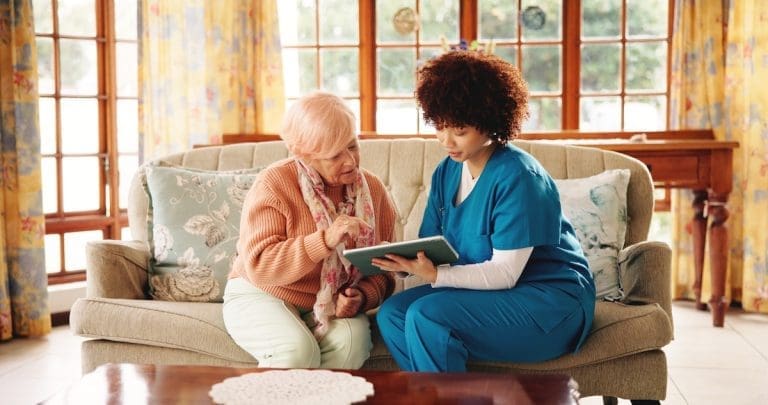High staff turnover continues to be an issue in senior living. In a recent Senior Housing News article, Michelle Hamilton, the COO of Commonwealth, was quoted saying “registered nurses and frontline caregivers are still among the hardest senior living roles to fill in the face of stiff competition from hospitals or other health care organizations.”
While some communities are rolling out flexible scheduling, higher pay, free meals and other non-standard perks to attract new employees and retain existing ones, other community leaders are looking for ways to be more efficient and lessen the team member burden. They understand that when a caregiver duplicates efforts, struggles to find important information and spends time on menial tasks that person is not happy.
More innovative and forward-thinking leaders are upgrading older eCall and life safety technology to modern, feature-rich and intuitive systems that have the power to reduce alarm fatigue, route calls appropriately and help managers spot trends that could reduce or eliminate adverse events.
Here are five ways that rethinking your eCall system can help improve employee efficiency and satisfaction, which in turn may reduce staff turnover.
#1 Eliminate Alarm Fatigue
Alarm fatigue is a challenge in any community. When residents call for help for everything from asking questions about the dining menu to confirming that help is on the way, it’s hard for anyone to prioritize whom to help first. That’s because legacy systems can’t determine who has the most urgent need. Today’s state-of-the-art eCall solutions prioritize health needs over informational calls. They decipher the most meaningful alarms automatically. Modern systems can:
- Leverage a sophisticated rules engine to create alerts only for certain conditions
- Alert a caregiver when a resident is ambulating without needed medical equipment, such as a walker, or is near someone with whom they don’t get along
- Prioritize alarms over notifications and rank them so that caregivers can respond to the most important conditions first
- Send alarms for maintenance-related issues (e.g., low batteries) to the Maintenance team
- Use a wireless system that allows you to add or delete devices easily for resident specific care needs
- Reduce adverse incidents by geofencing an exit corridor with a dwell time rule tied to known elopers that creates the alarm immediately once the resident enters the exit corridor
- Provide a passive assurance that someone is up for the day when they pass a sensor or trigger pathway lighting at night
- Create a better work environment by using a quiet, smart app, instead of a loud pager or radio
#2 Employ Efficient Routing
Every caregiver cannot respond to every alarm; yet, that’s the expectation when every caregiver receives the same alarm. Modern eCall systems that leverage RTLS technology can identify and match staff and resident locations and eliminate inefficient routing, while a caregiver’s acceptance of an alarm means it goes quiet for everyone else.
Today’s eCall systems help the right staff respond faster:
- Identify the location of a resident
- Locate the nearest caregiver and if that caregiver is already with another resident
- Send alarms only to those tasked to respond
- Give the responder the ability to let the team know the request is being handled
- Request backup when needed
- Signal staff members on break
- Let the resident know that the alarm has been acknowledged and the name of the caregiver who will help

#3 Simplify Alarm Response and Documentation
Because typical eCall solutions require the caregiver to close an alarm physically by pressing the call button, they often remain open much longer than necessary. This results in escalated alarms even when escalation isn’t needed. It also provides a false and elongated response timeline, making it difficult to staff appropriately. Modern alarm systems can be closed automatically and easily based on several factors, eliminating or minimizing escalations. These same modern alarms simplify documentation by allowing a caregiver to use icons to add a disposition and notes For example, new eCall platforms enable staff to:
- End the alarm from a mobile device when within a defined proximity of the resident requesting assistance so care staff can respond quickly
- Remove the alarm from the list automatically when the alarm is closed
- Customize how alarms are closed (at the source, from the desk application, and from the mobile app) to improve workflows
- Enable to caregiver to add a disposition and notes easily by selecting a series of icons to document the incident and add notes if needed
#4 Provide Information Not Just Noise
Today’s technology gives caregivers fingertip access to information and history that helps them respond more efficiently and more effectively. Modern systems provide data and information such as:
o Provide resident name, location of alarm generation, photo, type of alarm, device that created the alarm, the amount of time the alarm has been open, who is responding, and even a history of notes
o Give caregivers the ability to search easily for the resident, staff or tagged item location from a desktop or mobile device
o Integrate EMR information to provide a complete picture of the resident’s overall health and wellness such as DNR status, fall risk, two-person assist, allergies and more (with the authorizations and within HIPAA guidelines)
#5 Provide Actionable Insights
Many legacy alarm systems offer minimal information like the time an alarm was initiated and closed as well as the apartment number. New modern systems provide a lot more insights than standard reports. Community leaders can access graph-based dashboards, drill-down capabilities and AI-based insights that make it easier to identify changes in resident and staffing trends that require review and a thoughtful response. Look for a solution that can:
o Identify resident-required staff time easily to help bolster family confidence during care plan meetings
o Identify a significant or trending change in a resident’s routine such as more time in the bathroom, less time out of the apartment, more frequent calls for assistance, and more requests due to confusion
o Determine individual staff response times and time spent providing care, to facilitate opportunities to coach or praise
Create a Better Work Environment
Lessening the burden of your team will go a long way toward helping them enjoy their jobs and retain their positions. State-of-the-art technology will make them more efficient and allow them to help more residents. Sophisticated, quieter and smart alarm systems that target the right staff, help you eliminate the constant and annoying all-staff alarms, and make the overall senior living environment more pleasant. At a time when staff turnover continues to be high, technology improvements can help you retain and even attract caregivers.
Learn more about the modern RTLS-based eCall and life safety capabilities of Ensure360.



